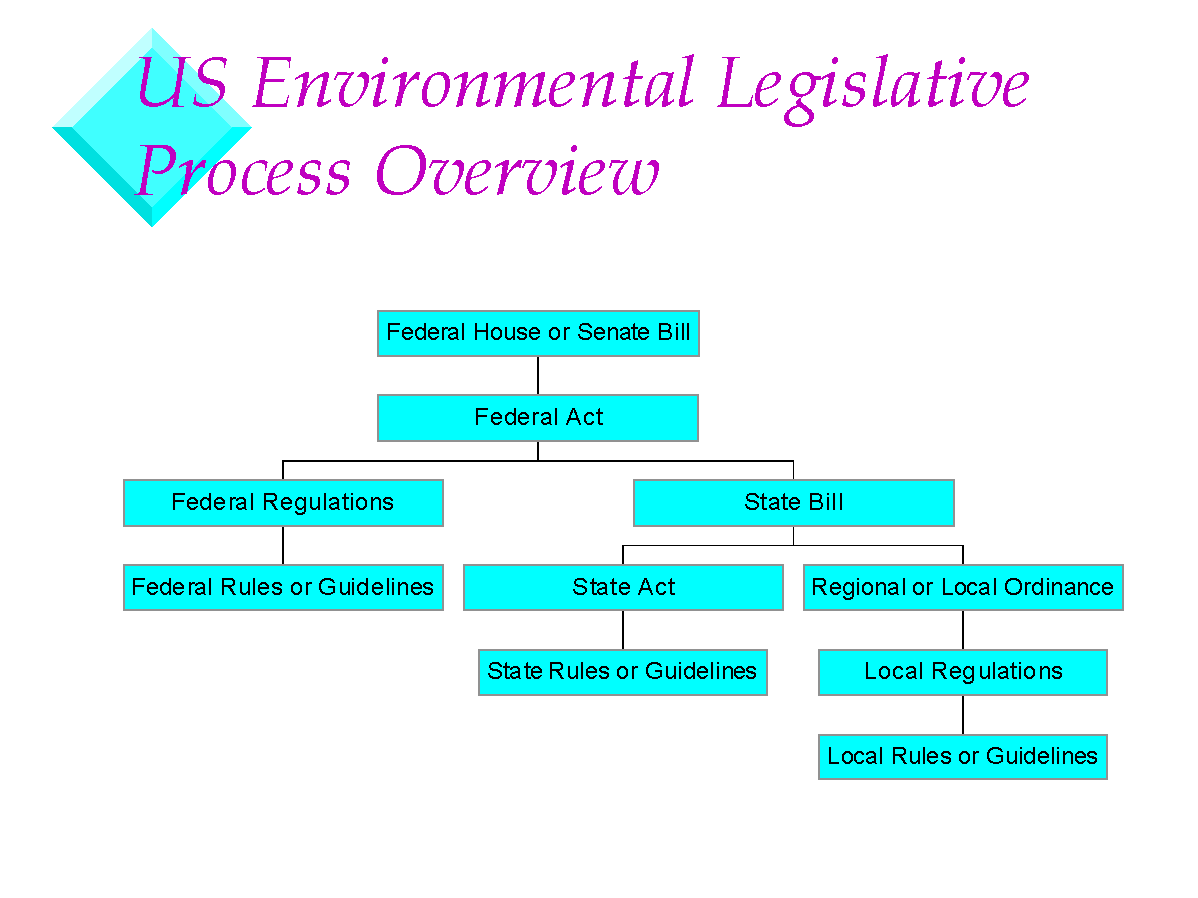For a more entertaining description of this process, check out Schoolhouse Rock!'s 'I'm Just a Bill' on You Tube.
Objective:
Goals:
Assignments:
LAWS and REGULATIONS
The American legislative system is based on common law. In common law, laws are made based on court rulings. So, the law is developed and evolves as it needs to based on court rulings. This does create a significant weakness for the law in that it cannot act pre-emptively. Therefore, the government (federal, state, or local) may pass laws to provide legal guidelines or regulations prior to a situation arriving in a court room. When the government determines that a law is required it is developed as shown below.

For a more entertaining description of this process, check out Schoolhouse Rock!'s 'I'm Just a Bill' on You Tube.
For Environmental Engineers, this provides information on what the Federal government requirements are. State regulatory requirements have to be at least as stringent as the Federal requirements. In many cases, States have simply adopted the Federal requirements.
A Little History
- Rivers and Harbors Act of 1899
- Often cited as the oldest U.S. Federal environmental protection law - was it really about the environment?
- Timeline of major U.S. environmental and occupational health regulations (1947-2016)
- Federal solid waste related regulations were passed in 1965, 1969, 1976, 1980, 1986
- 1970 - US EPA created
- Review: Textbook: Worrell & Vesilind, Solid Waste Engineering, 2nd edition, A Tale of Two Barge (pp. 1xii-xvi).
Review: The RCRA Regulations ( Title 40 CFR Parts 240-299)
- Chapter I(Roman Numeral), Subchapter I(letter), Part 258 pertains to MSW Landfills.
- FIND and take a quick look at several of the headings under Part 258
Read: RCRA Orientation Manual (PDF file) *
* These documents are Adobe Acrobat PDF (Portable Document Format) files. They can be viewed, and printed, with the use of an Adobe Acrobat Reader. The Adobe Acrobat's Reader is available, free, for Unix, Macintosh, IBM DOS, and IBM Windows operating systems. Click this button to download the latest version of Adobe Acrobat. The readers are available directly from Adobe.
RCRA Solid Waste Definition:
According to the EPA regulations, solid waste means any garbage, or refuse, sludge from a wastewater treatment plant, water supply treatment plant, or air pollution control facility and other discarded material, including solid, liquid, semi-solid, or contained gaseous material resulting from industrial, commercial, mining, and agricultural operations, and from community activities.
Practical Definition of Solid Waste:
Solid waste generated by a community
WHAT ABOUT HAZARDOUS WASTES?
RCRA §1004(5) definition:
A solid waste, or combination of solid waste, which because of its quantity, concentration, or physical, chemical, or infectious characteristics may (a) cause, or significantly contribute to, an increase in mortality or an increase in serious irreversible, or incapacitating reversible, illness; or (b) pose a substantial present or potential hazard to human health or the environment when improperly treated, stored, transported, or disposed of, or otherwise managed.
Practical Definition of a hazardous waste:
To be regulated under RCRA as a hazardous waste, a waste must first be a solid waste as defined by RCRA.
A waste is a RCRA hazardous was if it meets the solid waste stipulation, it is not specifically excluded from regulation under RCRA, and it is either:
What are some RCRA Subtitle D Wastes (nonhazardous wastes)?
- Municipal Solid Wastes (MSW)
- Household hazardous wastes
- Municipal sludge - accumulated solids, residues, and precipitates generated as a result of waste treatment or processing, including wastewater treatment, water supply treatment, or operation of an air pollution control facility, and mixed liquor and solids pumped from septic tanks, grease traps, privies, or similar
- Nonhazardous industrial wastes - Solid waste generated by manufacturing or industrial processes that is not a hazardous waste regulated under Subtitle-C. Such waste may include but is not limited to, wastes resulting from the following manufacturing activities: electric power generation, fertilizer/agricultural chemicals, food and related products/by-products, inorganic chemicals, iron and steel manufacturing, leather products, nonferrous metals, organic chemicals, plastic and resin manufacturing, pulp and paper
- Municipal combustion ash
- Small quantity generators' hazardous waste
- Construction/demolition debris- building materials, packaging, and rubble resulting from the construction, remodeling, repair, and demolition operations on pavements, houses, commercial buildings, etc. bricks, concrete, soil, rock, lumber, road spoils, rebar, etc.
- Agricultural waste - resulting from activities such as planting and harvesting crops, production of milk, slaughter of animals, and the operation of feedlots
- Oil and gas wastes
- Mining wastes
municipal solid waste (non-hazardous, subtitle-D wastes).